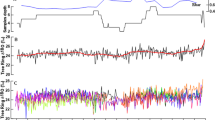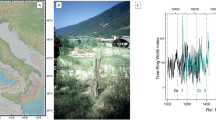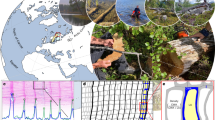Abstract
THE stable carbon isotopic (13C/12C) record of twentieth-century tree rings has been examined1–3 for evidence of the effects of the input of isotopically lighter fossil fuel CO2 (δ 13C∼−25‰ relative to the primary PDB standard4), since the onset of major fossil fuel combustion during the mid-nineteenth century, on the 13C/12C ratio of atmospheric CO2(δ 13C∼−7‰), which is assimilated by trees by photosynthesis. The decline in δ13C up to 1930 observed in several series of tree-ring measurements has exceeded that anticipated from the input of fossil fuel CO2 to the atmosphere, leading to suggestions of an additional input ‰) during the late nineteenth/early twentieth century. Stuiver3 has suggested that a lowering of atmospheric δ 13C of 0.7‰, from 1860 to 1930 over and above that due to fossil fuel CO2 can be attributed to a net biospheric CO2 (δ 13C∼−25‰) release comparable, in fact, to the total fossil fuel CO2 flux from 1850 to 1970. If information about the role of the biosphere as a source of or a sink for CO2 in the recent past can be derived from tree-ring 13C/12C data it could prove useful in evaluating the response of the whole dynamic carbon cycle to increasing input of fossil fuel CO2 and thus in predicting potential climatic change through the greenhouse effect of resultant atmospheric CO2 concentrations. I report here the trend (Fig. 1a) in whole wood δ 13C from 1883 to 1968 for tree rings of an American elm, grown in a non-forest environment at sea level in Falmouth, Cape Cod, Massachusetts (41°34′N, 70°38′W) on the northeastern coast of the US. Examination of the δ 13C trends in the light of various potential influences demonstrates the difficulty of attributing fluctuations in 13C/12C ratios to a unique cause and suggests that comparison of pre-1850 ratios with temperature records could aid resolution of perturbatory parameters in the twentieth century.
This is a preview of subscription content, access via your institution
Access options
Subscribe to this journal
Receive 51 print issues and online access
$199.00 per year
only $3.90 per issue
Buy this article
- Purchase on Springer Link
- Instant access to full article PDF
Prices may be subject to local taxes which are calculated during checkout
Similar content being viewed by others
References
Farmer, J. G. & Baxter, M. S. Nature 247, 273–275 (1974).
Freyer, H. D. & Wiesberg, L. Nature 252, 757 (1974).
Stuiver, M. Science 199, 253–258 (1978).
Craig, H. Geochim. cosmochim. Acta 3, 53–92 (1953); 12, 133–149 (1957).
Oeschger, H., Siegenthaler, U., Schotterer, A. & Gugelmann, A. Tellus 27, 168–192 (1975).
Wilson, A. T. Nature 273, 40–41 (1978).
Pearman, G. J., Francey, R. J. & Fraser, P. J. B. Nature 260, 771–773 (1976).
Woodwell, G. M. et al. Science 199, 141–146 (1978).
Grinsted, M. J., Wilson, A. T. & Ferguson, C. W. Earth planet. Sci. Lett. 42, 251–253 (1979).
Wilson, A. T. & Grinsted, M. J. Nature 265, 133–135 (1977).
Manley, G. Q. Jl R. meteor. Soc. 100, 389–405 (1974).
Author information
Authors and Affiliations
Rights and permissions
About this article
Cite this article
FARMER, J. Problems in interpreting tree-ring δ 13C records. Nature 279, 229–231 (1979). https://doi.org/10.1038/279229a0
Received:
Accepted:
Issue Date:
DOI: https://doi.org/10.1038/279229a0
This article is cited by
-
Variations in carbon isotope ratios of C3 plants and distribution of C4 plants along an altitudinal transect on the eastern slope of Mount Gongga
Science in China Series D: Earth Sciences (2009)
-
Sampling strategy for stable carbon isotope analysis of tree rings in pine
Nature (1984)
-
An explanation of 13C/12C variations in tree rings
Nature (1982)
-
Recent 13C/12C trends in atmospheric CO2 and tree rings
Nature (1981)
-
Tasmanian tree rings belie suggested anthropogenic 13C/12C trends
Nature (1981)
Comments
By submitting a comment you agree to abide by our Terms and Community Guidelines. If you find something abusive or that does not comply with our terms or guidelines please flag it as inappropriate.



